Mother Nature Sometimes Delights In Showcasing Just How Formidable She Can Be
When dealing with nature, there are many unknowns. Sometimes, we are torn between what we want to explore and what we do not want to know about! Often, we fall across a photo of the most jarring things mother nature has to offer, yet we cannot take our eyes off them. Why? It can get too fascinating, intriguing, and maybe a little disgusting. Some of these images may come to you as surprising, but reading through the descriptions will help you see and understand a different side of nature. Here is a body of well-researched facts about some of the most amazing things nature offers. Prepare to have your mind blown to bits with thrilling facts and cringe-worthy image descriptions from a comical angle. Let us dive into some of the rarely seen moments caught on camera.
Baby Alligator Snapping Turtle
Here is another small-sized species of a popularly known animal. From its looks, it appears to be just like a dinosaur. This species of alligator is reported to have a lifespan of about 200 years, and the maximum attainable weight is more than 200 pounds on average. The Shedd Aquarium in Chicago has the record for hosting an enormous alligator snapping turtles at about 245 pounds of weight.
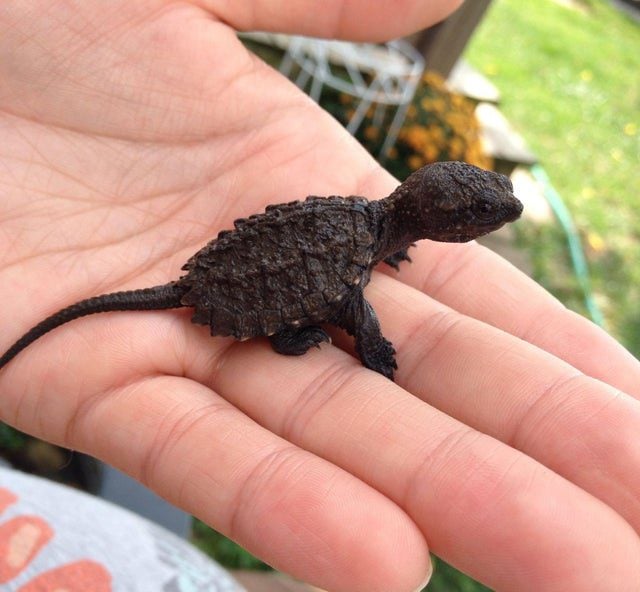
There was a rumor that there was a sighting of an alligator snapping turtle that weighed about 403-pounds in Kansas during the great depression. The reports went unconfirmed; a picture of it would have been well preserved in a national museum, but it was nowhere to be found. Baby-sized alligator-snapping turtles feed on tadpoles, small fishes, and earthworms. As they enlarge, they graduate to feeding on more giant aquatic animals.
Incredibly Rare Irrawaddy Dolphin
There are only about 92 Irrawaddy dolphins left in existence. They have a short beak with a range from 12-to 19 teeth on either side of their jaws just beneath the most enormous forehead you’ll ever see. They can dwell in freshwater and saltwater, and they grow up to 400 pounds and a length of about 8 feet.
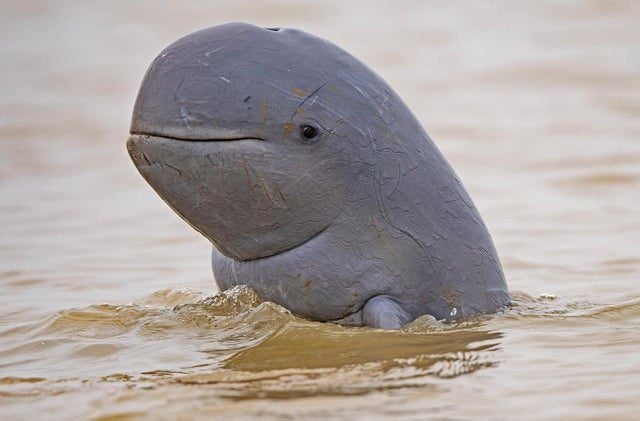
Where can they be found? They can be found on aquatic bodies such as estuaries and rivers located in Southeast Asia and around the Bay of Bengal. They majorly feed on crustaceans, fish, and cephalopods. According to scientists, they are very slow swimmers, and they can live for more than 30 years.
World’s Largest Eagle
Have you ever heard of the harpy eagle? It is distinctly the largest eagle in the world. They are breeds commonly found in South America. It has a wingspan of about six feet when spread wide. They are big gamers in the Amazonian wild and terrorize deer, monkeys, and sloths.
Forget all their appellations; they are not intimidating and can be awfully quiet when away from their nesting areas. Their prey will feel some dread, though as this bird is at the top of the food chain and a threat to animals of its size. The bird is the national bird of Panama due to its appearance and size.
Hairless Chimp
You’d expect a chimpanzee to be full of hair and with a little less muscle. But shall we say that this guy has been spending some time at the gym? That doesn’t account for the hair loss, by the way. The medical term you are looking for is Alopecia. A chronic disease that causes both humans and animals to lose a lot of hair.

However, it gives us a glimpse of how muscular a chimp can actually be. It could support the suggestions that chimps can rival a man pound for pound in terms of strength. Who knows? They could even get 3 to 5 times stronger than a man. Native to the African Tropical rainforest and savannah. They live in groups of 15-150 members.
Same Humpback Photographed 35 Years Apart
These two pictures are images of the same whale captured about 35 years apart. The picture to the left shows the tail as captured in 1985, compared to the tail in 2020. You could refute that by saying, “O! It could be another whale,” But that is doubtful considering that humpbacks can live for as long as 90 years.
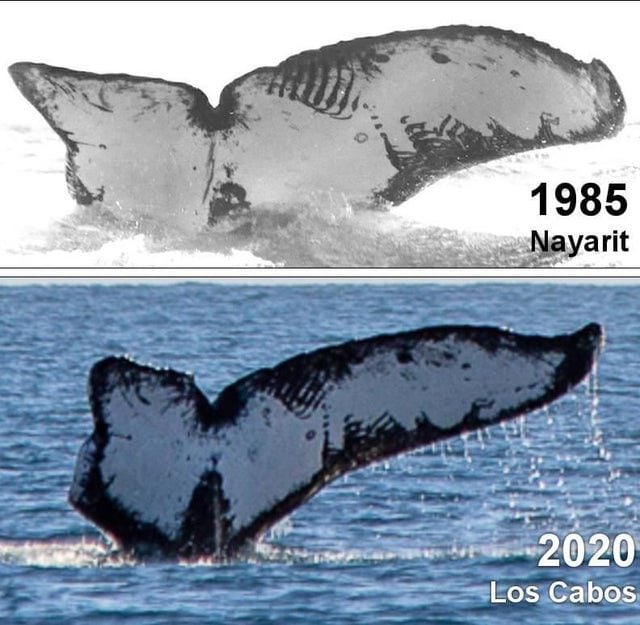
They are commonly found in oceans worldwide and measure 60 feet in length and more than 80,000 pounds of weight. They can travel over 25,000 kilometers annually in search of favorable habitats. They feed on plankton as well as small fish. They are touted to be able to consume 3000 pounds of food every day.
Lightning Tree
It appears to be a phenomenon only told of in fantasy movies. But this is real life. Here we see the photo of a tree taken shortly after lightning struck it. The tree is burning on the inside. This species of hollow tree is known to be able to act the same way a chimney does, with only the smoke to show after doing all the burning.
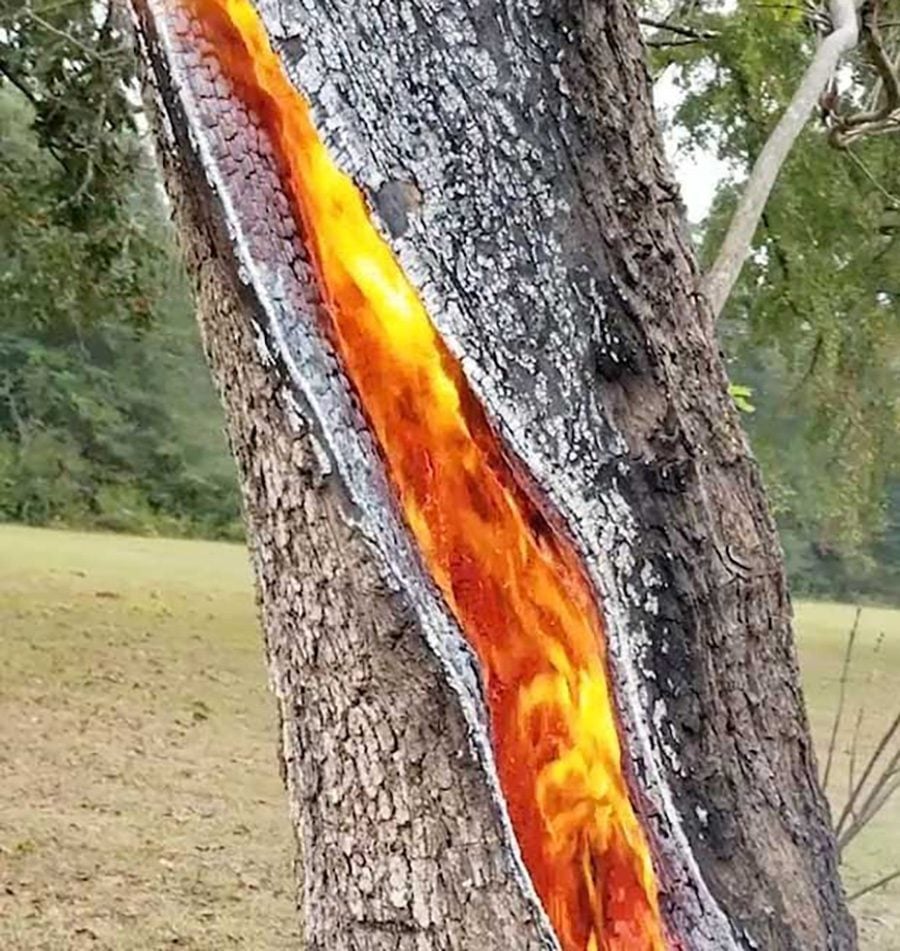
The water retained in the tree is burned by the heat and passed out as steam. If the lightning generates heat just below the bark, the surface moisture of the tree is converted into steam. The blast creates a hole in the tree that kills it and leaves it with the marks you can see in the picture.
Baby Gorilla and Baby Chimp
Here is a rare photo of a gorilla and a chimpanzee playing together. We have photographer Michael Poliza to thank for this beautiful picture. This is fascinating because adult gorillas cannot tolerate other animals due to their territorial instinct and aggressiveness.
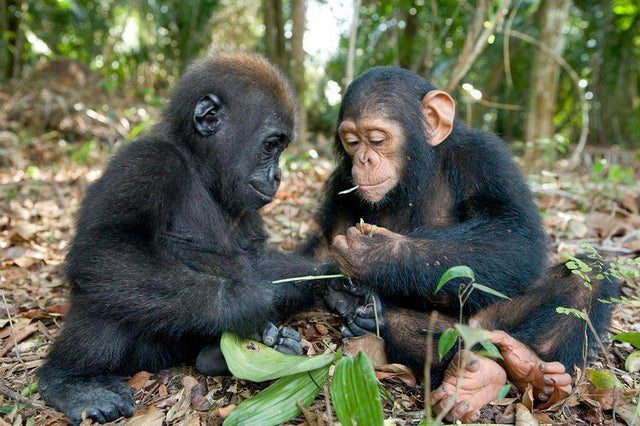
It depends on the type of gorilla, by the way. This particular gorilla could grow way more significant in size than the chimps and are capable of quite the destruction. Chimps are a bit timid and smaller in size, though. A mature male gorilla can grow as big as 453 pounds, and when stood upright, it can tower at about 5.6 feet. No chimpanzee can match that.
Lava Falling in the Hawaiian Jungle
This natural scene may not be so typical anymore. It is incredible to see lava flowing so freely in Hawaii. Welcome to the jungle, which is the home of Kilauea, an active volcano located in one of the beautiful Hawaiian Islands. There are five other volcanoes on the Island in the region, but it is the most active.

In over a century, the volcano has erupted 50 times. The crater pit of the volcano is the Halemaʻumaʻu. It used to hold a lava lake for ten years between 2008 and 2018. The last eruption was in April 2018. The two neighboring towns were destroyed, and there was nothing to salvage.
Wave Swallowing a Lighthouse
This picture was captured by Jean Guichard in 1989, just outside Northern France. Here we see a giant wave swallowing a lighthouse with people on it. The man in the photo seems a little too relaxed for what seemed like a disaster.

The water ripped off the front door, which swept the furniture away. Guichard used a helicopter to get the pictures, despite the weather conditions. The man in the photo was the lighthouse keeper Théodore Malgorn. He took refuge in the lantern room. When he heard the helicopter, he assumed it was there to rescue him and rushed downstairs. After the huge wave hit, Malgorn ran back inside.
Whale Pregnant vs. Not Pregnant
We got twice lucky with this killer whale caught on camera in two consecutive years. The first picture has the killer whale swimming through the water with its calf in tow. We learned that the calf passed away not too long after birth, and the whale was not seen until a year later. This time, her physique appeared entirely different.
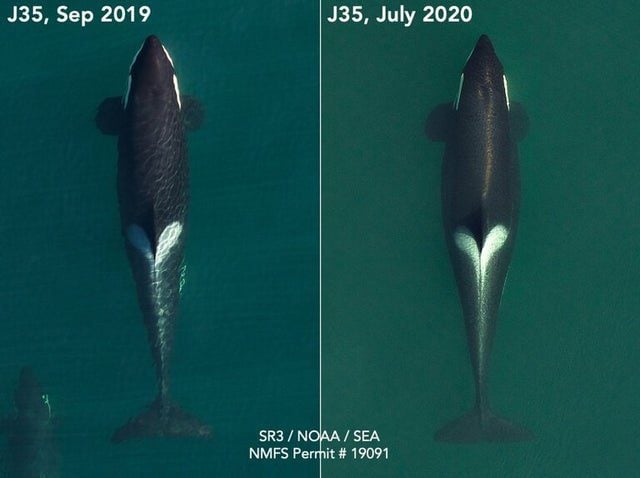
Her body frame appears to have widened around the middle, suggesting that she was pregnant. A fun fact about killer whales is that when they start reproducing at 20 years of age, they can breed up until age 40, when their fertility declines. Males can reproduce from the age of 21 despite reaching maturity at 15.
Humpback Whale Opening Its Mouth
Humpback whales are a different class of whales classified as baleen whales. What does that mean? It means that they have got bristly plates for teeth. They don’t chew but filter and trap their tiny prey, such as small fish and krill. However, they can filter feed up to 3000 pounds of their diet per day.
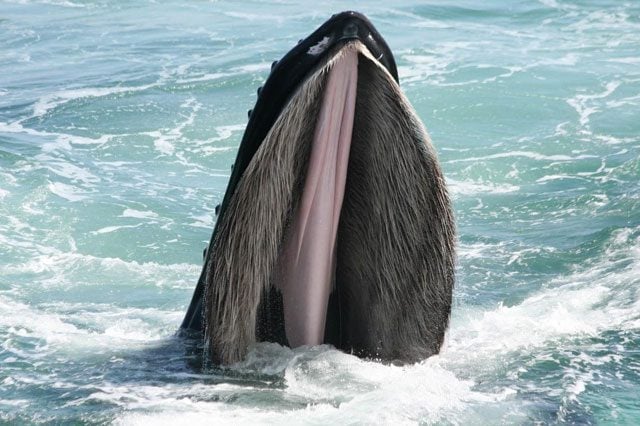
To trap enough prey in their mouth, they raise their jaws at an inclined angle and expand their throat pleats taking in a mouthful of game plus water. They possess a tongue that functions like a sweeper to release water between the bristly plates in the mouth.
Melanistic and Albino Alligators
Albinism is a medical term that defines humans or animals with exceptionally light pigmentation. Melanism might be a relatively new term, but it talks about an unusually high skin composition that results in a dark complexion. Certain rare groups of alligators tend to exhibit either melanistic or Albinism tendencies.
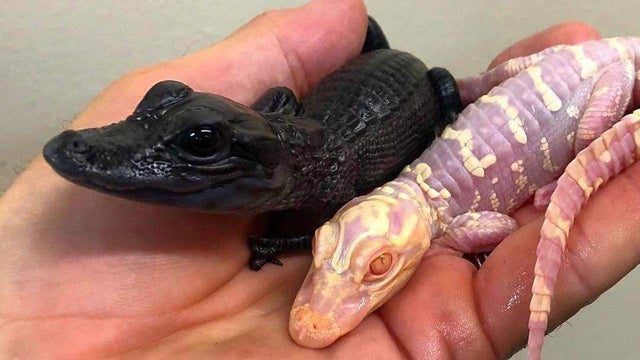
According to data, the total number of melanistic and albino alligators worldwide is 20 and 300. We also have leucistic alligators with white or pale skin coloration. They are tough to find. That last sighting of one was in 1987, which was found in a remote Louisiana swamp before it was transferred to an aquarium in New Orleans.
Bison Struck By Lightning
This bison survived a lightning strike in 2013 and was given the name Sparky. He became a symbol of the strength and endurance of his species. He lived his entire life roaming the prairie in Iowa’s Neal Smith National Wildlife Refuge.
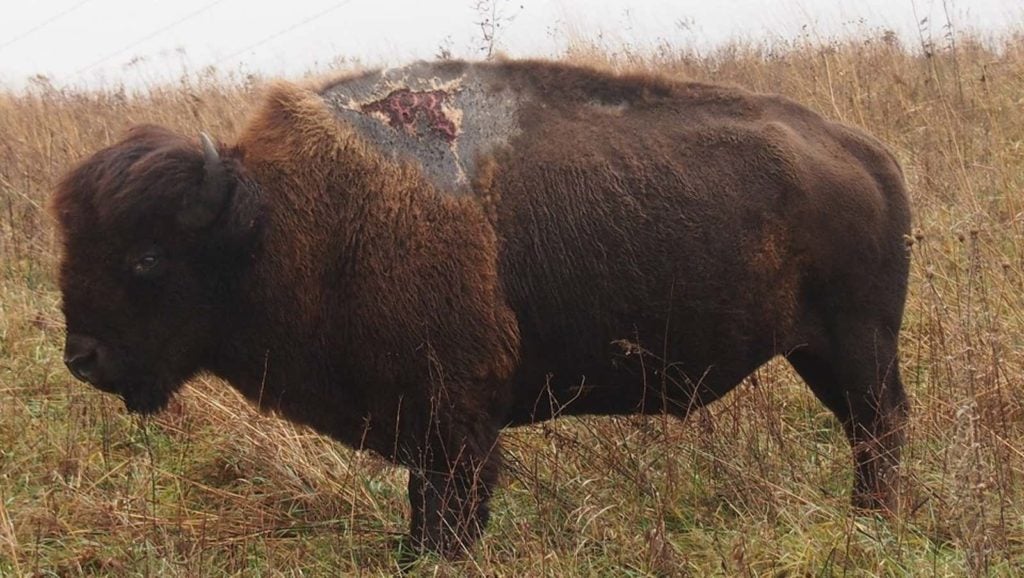
Sparky fathered three calves before the strike. Sparky is an American bison. There are around 500,000 bison on private lands and about 30,000 on public lands in the United States. They mainly consume cool-season grasses in their diet. For water, sometimes they eat snow.
Baby Swordfish
Is that a swordfish? Yes. But aren’t they deemed one of the large-sized freshwater fishes in the world? Biologically, their life cycle starts with them being the size of a microgram. At maturity, they can attain a jaw-dropping 1000 pounds. It falls in the category of species such as the marlin and sawfish. A typical marlin can weigh at least 1500 pounds, 14.6 feet in length.
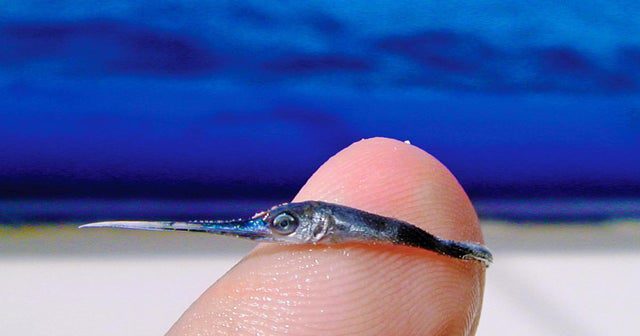
Some of the wildest reports we have heard from deep-sea fishers are that they once caught a marlin that weighed about 4500 pounds. And that was about 46 years ago. They could not weigh it without cutting it up into three parts. The Venezuelan republic has made a statue of the marlin and placed it at the country’s famous Cultural Pavilion entrance.
Dinosaurs Among Us
It is believed that the dinosaurs were wiped out by some tragic cataclysmic event billions of years ago. But there have always been speculations that a few of them might still be around. This should ease some of those concerns. Here is an image of a bird that likely evolved from Theropods, a nasty group of flesh-eating dinosaurs.
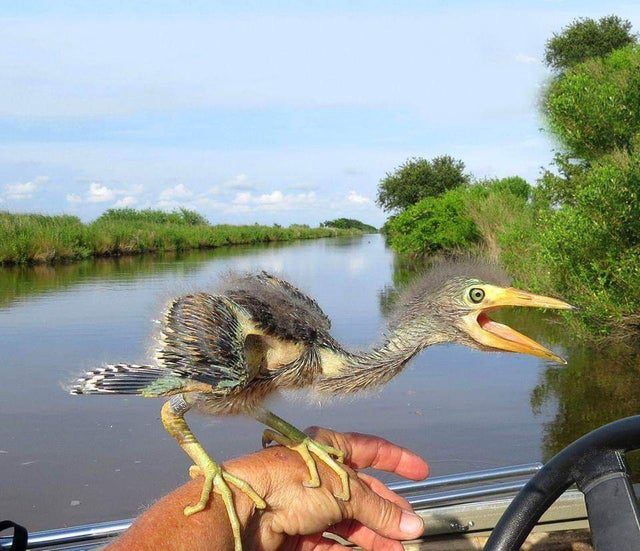
Therapods are siblings to the infamous tyrannosaurus rex, and some of the bird fossils are thought to be about 150 million years old. The birds are much smaller than their ancestors, with a smaller skull shape which makes them look like dinosaur embryos even when they reach adulthood. Their beaks are also more efficient at finding food, making nests, and caring for their young.
Marmot vs. Tibetan Fox
This pairing is indeed not weird at all. We have a former Wildlife Photographer of the year to thank for this once-in-a-generation image. Chinese photographer Yongqing Bao got lucky to capture the marmot’s scary encounter with the fearsome Tibetan fox. It looks so scared with its jaws open, almost screaming, “Oh crap”!
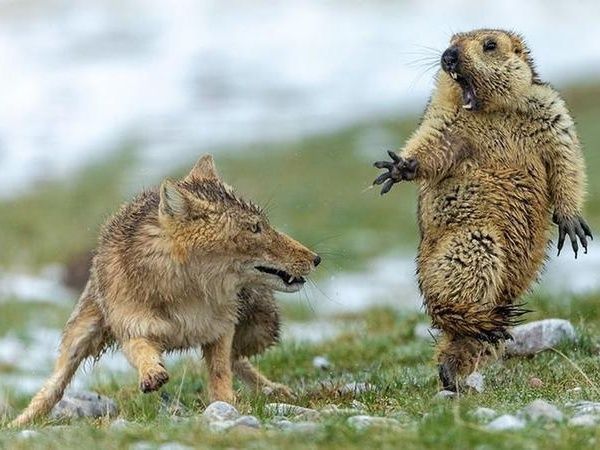
You can almost see the fur on its skin standing as it tries to get away from the Tibetan sand fox. Neither creature is scarce in any other region as it is native to the Qinghai Tibetan plateau. Wondering if the poor marmot made it? Other marmots tried to save it by distracting the fox but to no avail.
Goats Climbing a Brick Wall
Goats are a unique livestock class with a penchant for their capability to climb incredibly tough terrains. This one is a little on the impossible side, but you’ve got to believe what you see here. The hooves of goats are distinctly split into two, and they can grip larger surfaces with the aid of rubbery pads they have for feet.

The image shows us a picture of two stubborn goats climbing the wall of the Cingino Dam located in Piedmont, Italy. The goats belong to a breed known as the Alpine Ibex. What are they doing there? They were going for their all-time fave salt licks to balance their herbivorous diet. The goats became celebrities on air in 2021, having gained over 134 million views on BBC.
Mother Wolf Teaching Cubs to Howl
Science is oblivious to a large portion of interaction between a mother and her young one. We have an incredible instance right here for you. This loving mother wolf is teaching her cubs to howl. All wolves howl to send messages to other pack wolves or mark their territorial dominance in a place and ward off enemies.

A single howl can go as far as 6-7 miles. You can now understand what a weapon a howl can be for a wolf that belongs to a pack. They may live together and fight against other groups being the territorial animals they are. There are lone wolves who also practice the “lonesome howl .” It is equally effective in asserting their dominance where they want it.
What a Kangaroo’s Foot Looks Like
The picture below is a foot from a kangaroo’s large back leg. Kangaroos have four or five toes. If present, the first toe is tiny, while the second and third toes are fused together. Kangaroos have a bone-shattering kicking force of over 800 pounds of force per square inch (PSI).
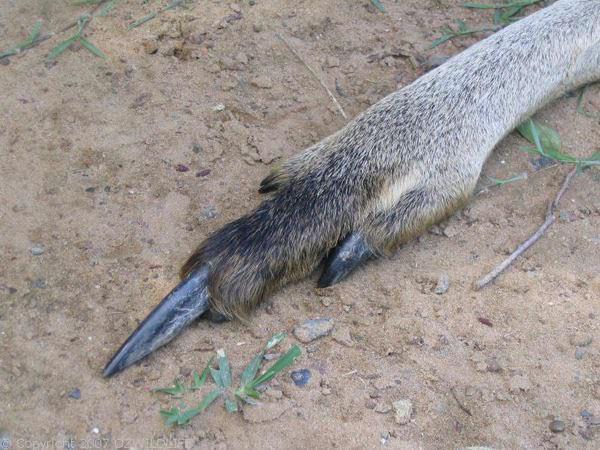
The second toe with the sizeable massive claw provides an essential function for the Kangaroo; it gives them traction when it hops. The fused toes are for grooming. The Kangaroo also has long Achilles tendons, and they stockpile elastic energy, which helps the animal jump.
Diver and Ocean Sunfish
The Ocean sunfish, also called Mola Mola, is enormous. They can weigh from 540 to 2,205 Ibs (247-1000 kg) and grow up to 5.9ft, making them one of the heaviest known bony fish. They prefer temperate and tropical water.
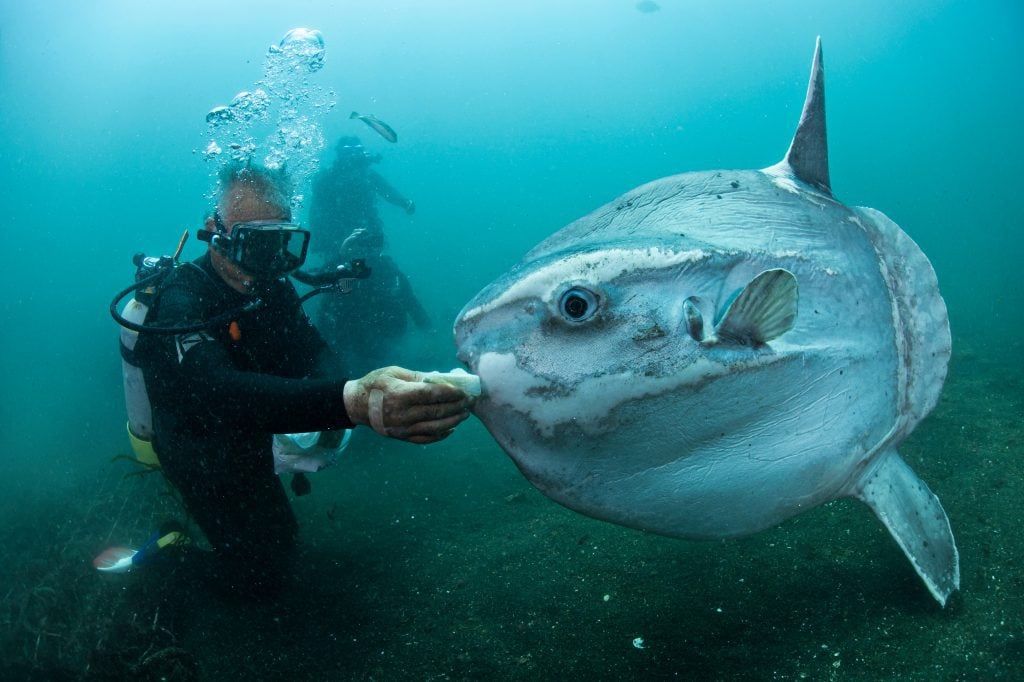
People can find them between the Atlantic and Pacific Oceans. They primarily eat tiny fish/fish larvae, squids, and crustaceans. On the flip side, killer whales, sharks, and sea lions will eat them. Some countries in Asia, including Japan, Taiwan, and Korea, consider them a delicacy.
Icy Seal Whiskers
While animals like cats and rats have around 200 nerve endings in each whisker, seals have an impressive 1,500. This allows them to find and catch fish, even without sight. Scientists claim their whiskers can size up a herring down to the centimeter.
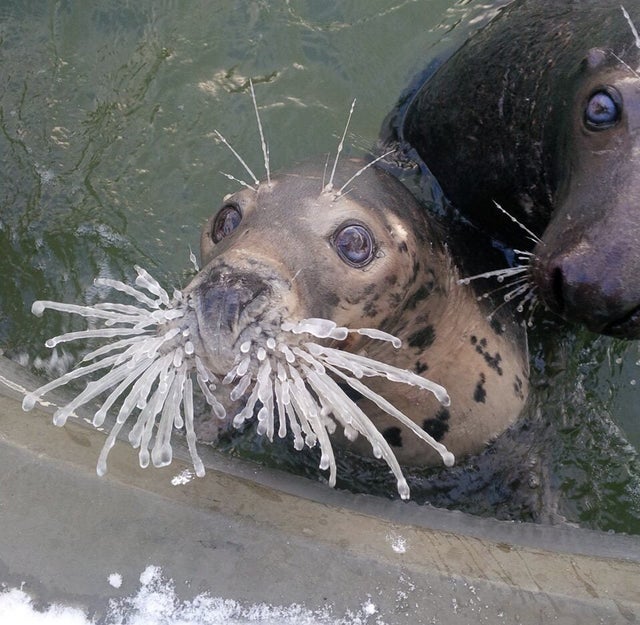
Unlike other mammals with rounded whiskers, Seals whiskers are wavy and irregular-shaped. The purpose is to steady the seal as it swims. Also, the whiskers exclusively shake when detecting hydrodynamic trails. A seal pulls its whiskers erect away from its face when tracking underwater.
Megalodon vs. Great White Shark
Sometimes it’s hard to fathom just how large ancient megalodons were. This photo compares a megalodon and the modern-day great white shark. These extinct sharks were giant, and they are presumed to have reached a length of 60 feet and a weight of over 40,000 pounds.
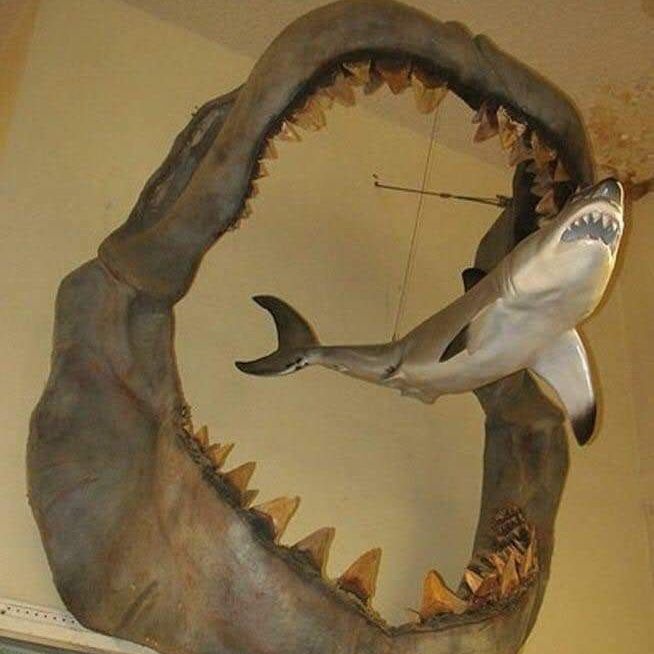
Scientists estimate that the megalodon lived between 2.3 to 3.6 million years ago. They classify it in the family of Otodontidae, though scientists still debate its genus. The creature also inspired popular culture, with creators making books, movies, and video games about it.
Lion Loses Tooth To Giraffe Kick
After losing a canine tooth, this photo shows a lion in agonizing pain due to a giraffe’s kick. It’s estimated giraffes can generate an impact of 2,000 pounds of force per square inch (PSI). They can also kick in any direction. They have been known to kill lions with their kicks.
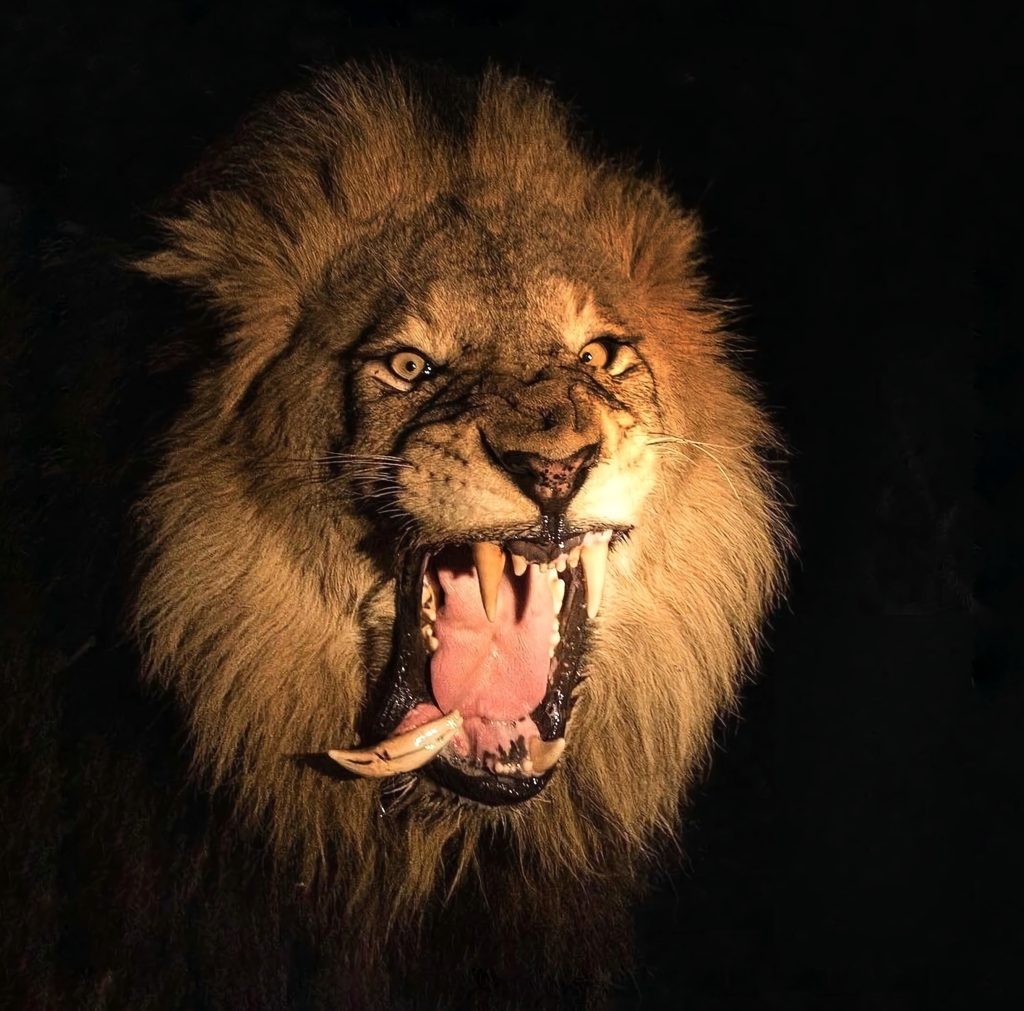
Giraffes have a high adult survival rate due to their size and kicks. Predators usually leave them alone, though lions prey on shorter and slimmer ones. Though not uncommon, single lions do not usually go after giraffes due to the risks.
Pufferfish vs. Moray Eel
The moray eel is a scarce sight, and this one, about 4 feet long, was spotted ashore on the Cook Islands. Its death was caused by the attack of the notorious pufferfish, which got stuck in the eel’s throat—a rare case of the predator getting served. The pufferfish is exceptionally bony and a thorn in the flesh of predators that try to eat them.
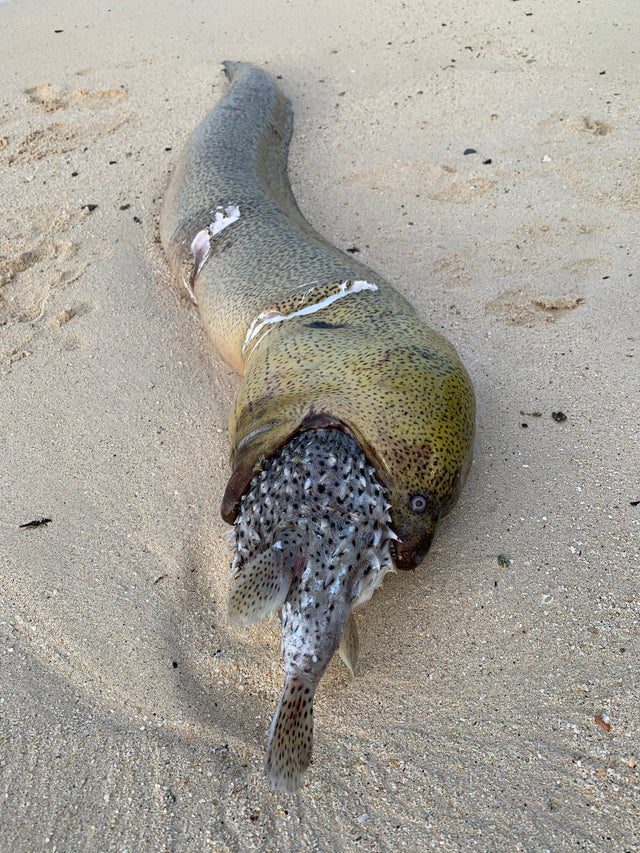
The eel has two distinct jaws, the oral jaw, which first bites into its prey, and then the pharyngeal jaws, which grip the game and drag it down the throat. Feeding on the pufferfish is not strange to the eel, but it seems this eel was wrong that day.
Newborn Flying Fox Clinging To Mother
The Indian flying fox is nothing like the wild foxes of the canine family that you are aware of. These are actually more like hairy bats. Usually, young flying foxes cannot fly for the first few months of their life. Adults, however, can get quite extensive with their wings spread apart at about 5.25 feet.
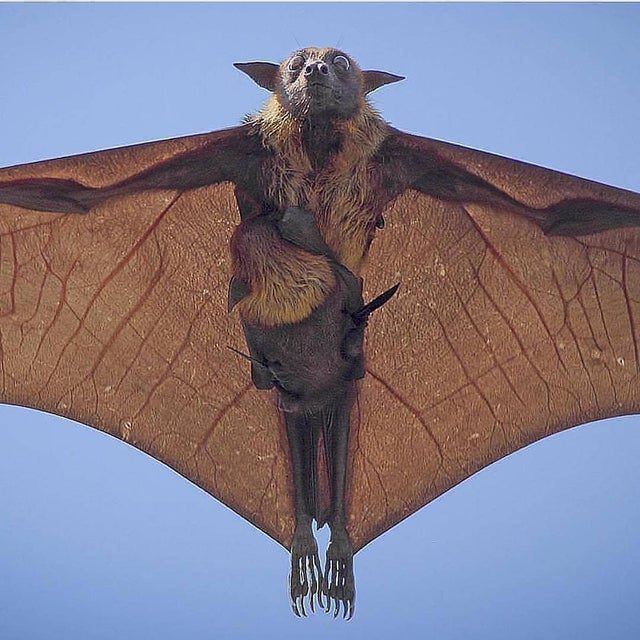
These bats are native to the wild jungle of Asia, Africa, Australia, and the islands around the Pacific. Unlike other bats, most flying foxes have decent eyesight and are not necessarily nocturnal. They live in colonies of about 200,000 strong. They also mate in the inverted position.
Noise on The Roof
After hearing a bird call on their roof, someone posted this image on social media. Many have identified this bird as a magpie, but others have a different opinion. It’s more identical to a currawong. White sharp beaks are peculiar to magpies, while currawongs tend to possess a curved tip beak with a single color.
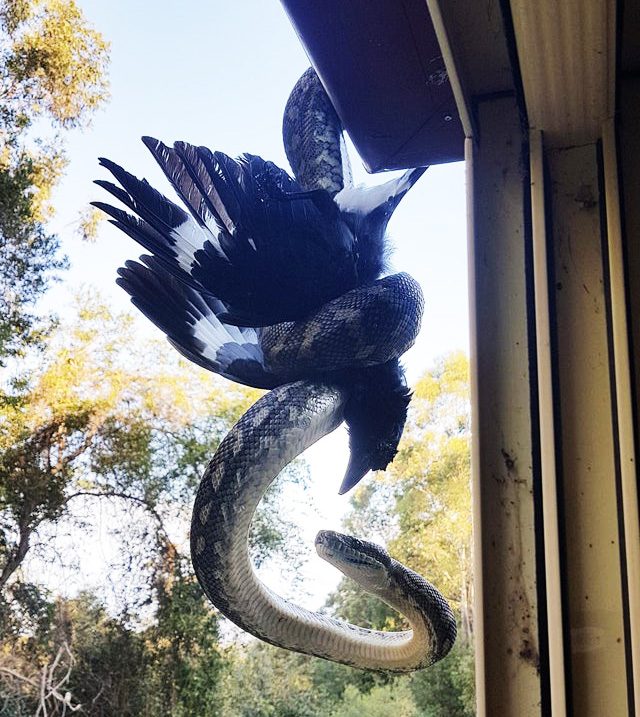
Ever seen a currawong before? It’s understandable; they are a rare bird species restricted to East Australia. Another rare species native to Australia is the formidable carpet python, which can grow up to about 2 meters in height and 4 meters in length.
Angler Fish Washed Ashore
It’s scarce to see an anglerfish outside of the deep ocean, but this one was found at Crystal Cove State Park in California. Anglerfish are typically found at ocean depths around 3,000 feet. The protrusion from the head is a modified dorsal fin known as the esca.
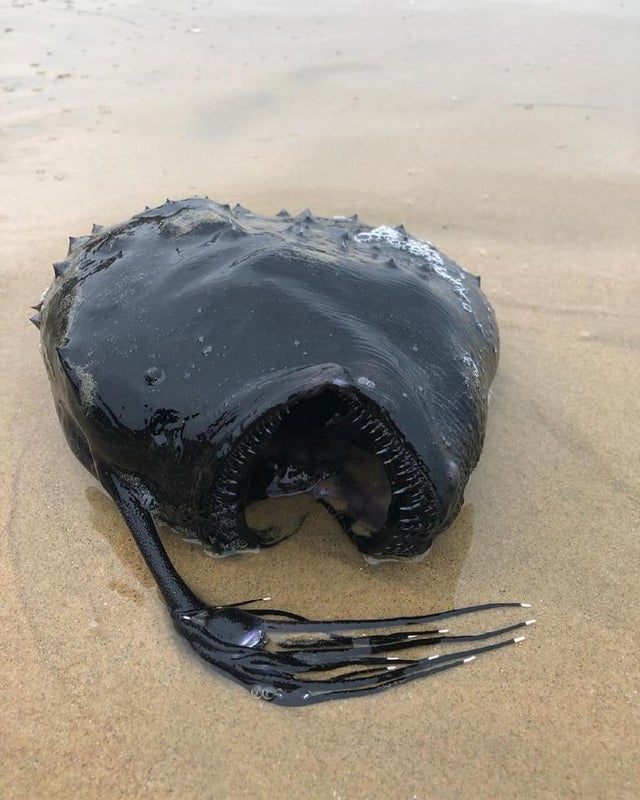
Its bioluminescence attracts prey that the anglerfish then impale with their sharp teeth. The esca is even known to attract predators, turning the hunter into the hunted. The one in the picture is specifically a Pacific football fish, one of the 200 plus species of angler fish.
Beluga Legs
It is widely acknowledged that whales, sharks and other sea mammals lack appendages. But the beluga appears to be an exception with what looks like legs. This image caused a frenzy among scientists who tried to describe the function of the symmetrical bone-like features of the tail.
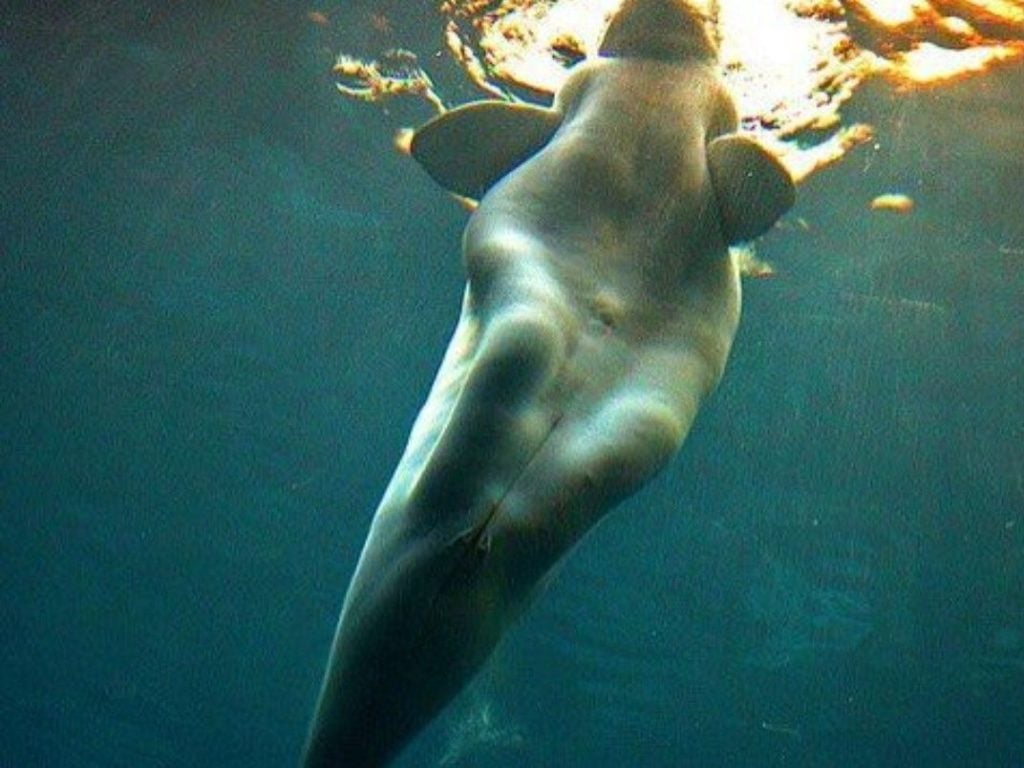
Though they cannot be classified as legs, they are instead referred to as blubbers. They are a row of fatty insulations that beluga whales accumulate on their side. Evolution supports suggestions that beluga whales might have descended from land creatures that existed over 50 million years ago. It means they may have had legs at some point.
Massive Tiger
Siberian tigers are the largest species the world has seen. We’ve got this Siberian tiger named Jaipur that holds the Guinness World Record for being the largest at nine when it weighed 423 kg and was about 10 ft 11 inches in length. Quite imposing, right? You don’t want to get caught in its sight when it’s having a bad day.
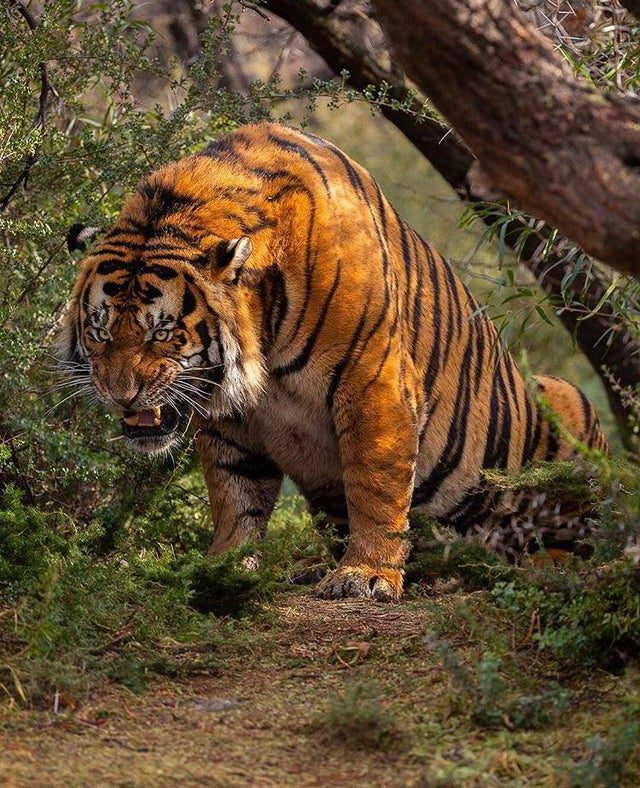
It has been holding the record since 1986, and it remains unbroken. Most Siberian tigers grow to about 6 ft 5 inches in length. They stand out as the most prominent species of tigers in the world. They do not hunt small prey but go after wild hogs, red deer and axis deer. They are remarkably good at fishing for food in aquatic bodies as well.
Impala Survives Lion Attack
Impalas are one of the smaller animals in the wild that never have things easy because they are so vulnerable. Most of their offspring fail to survive the first few weeks of life due to attacks by predators. This photo shows an impala that survived a lion’s attack, and the evidence is on its body.
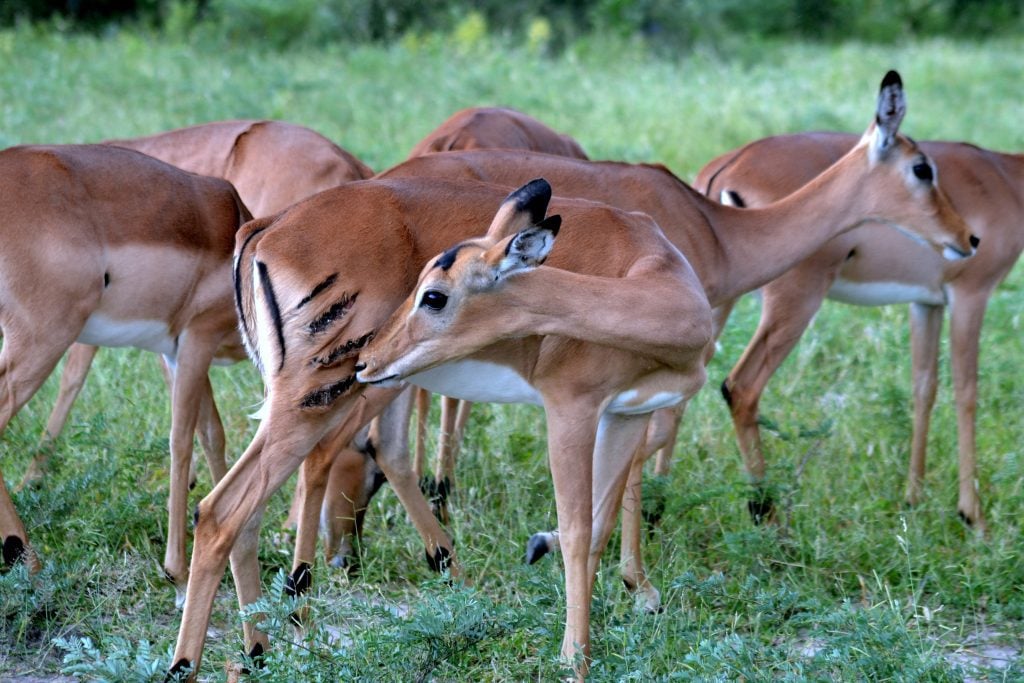
They are known to give birth at the sun’s peak at midday when predators are at rest. They are the only animals that are thought to be able to delay parturition by about a month. They have an incredible jumping ability which can be used to evade predators.
Seagull Attempts to Help His Mate
Here’s a rare image of solidarity between seagulls where one is attempting to save its kind from the ferocious bald eagle. A bald eagle is probably the worst form of predator for a bird-like seagull. They are voracious eaters when they reach the mature weight of about 17 pounds.
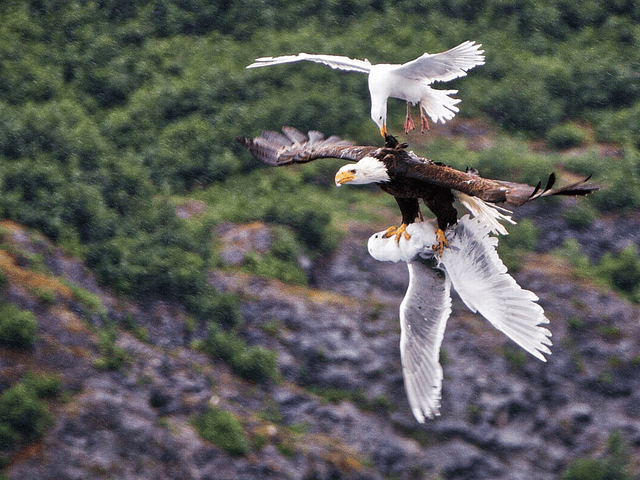
Research has shown that a bald eagle nest can weigh about 2000 pounds. Bald eagles are known to feed on fish but can also prey on smaller animals and birds. They can be the nasty scavengers who don’t mind stealing from other predators, including their own kind.
Hyena vs. Wild Dogs
Hyenas are never known to walk alone, and together they can be quite the challenge for a lion. This one seems to be having an off-day, and it could probably be its last day on the earth. Maybe if it had another hyena, they could cooperate in warding off attacks from this pack of wild dogs.
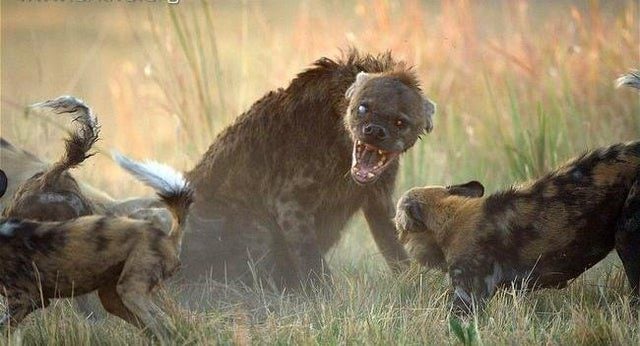
Hyenas have unique problem-solving skills and can communicate with one another without making a single sound. Brown hyenas are notorious for their ability to feign death in the face of danger. In contrast, like the spotted hyena, others are quite the fighters. This species might not be either of the two, but it sure is ready to put up quite the fight for its life.
Wolf Eel
The wolf eel is only an eel by name but not exactly an eel. On the contrary, it’s simply a long kind of skinny fish. Although, it is thought to be relatively young. It suggests that it could probably be much more significant as it ages. The image shows that the young wolf eels have a characteristic red brick-like color.
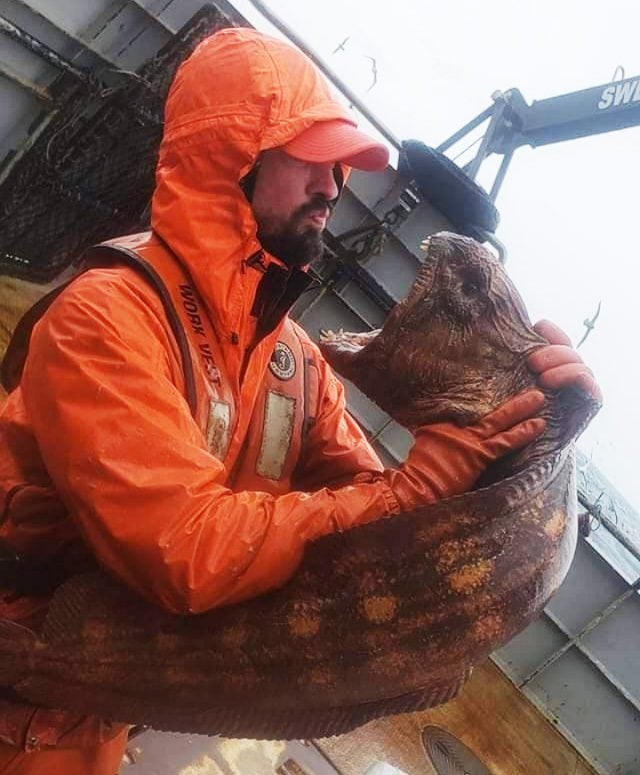
The colors begin to fade into differing patterns of gray and brown. In the adult stage, it can grow in length up to 8 feet, and it would have almost 300 spinal vertebrae. They are a friendly species of fish renowned for their gentleness and remarkably slow movement in the water.
Catfish Tries To Swallow Turtle
Catfish are not as docile as you might think about their feeding habit. They can eat anything thrown their way, and this one seems to have met its match in the relatively gentle turtle. Fishermen often feed them hot dogs, dog food, gummy worms, and persimmons. It failed to subdue the turtle as neither of them survived the encounter.
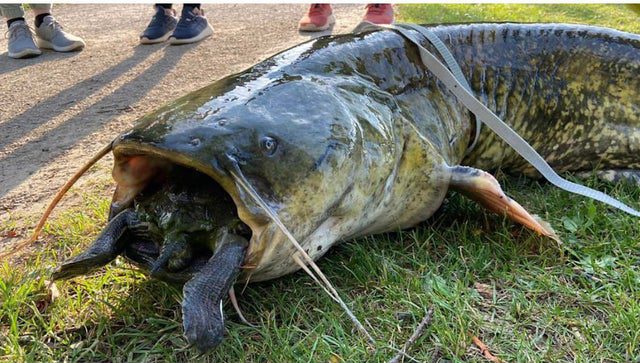
Catfish have barbels that look like cat whiskers and belong to the order Siluriformes. They come in different sizes, and they have large species, such as the Wels catfish and the Making giant catfish, which appear true to their name. They are rarely found at the water’s surface because they are bottom feeders and tend to sink due to their bladder.
Tree vs. Shipping Container
These images show a shipping container somehow entangled with a tree after a flood. The tree appears strong as it’s barely shaken. Botanists will agree that it probably has an extensive rooting system that could withstand the full strength of the massive container. The tree’s trunk seems to have a bit of bulk to go with its deep roots.

Most trees have their trunk rising from a depth within the soul and rising to the last branch extension. The trunks have hard protective sheaths/barks that protect the nutrients that it conveys from the roots to other parts of the tree. Leaves and branches can reach higher to receive direct sunlight and nutrients from the trunk.
Elephant vs. Car
Talk about being in the right place at the right time; that’s the case of this incredible encounter between this unlucky car and the massive adult elephant. If we try to guess, this elephant probably weighs between 5,000 to 14,000 lbs. You can expect that the car didn’t go unscathed.
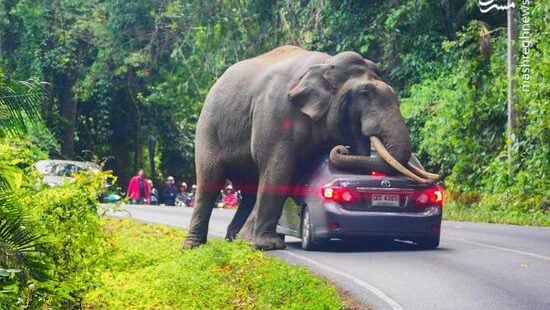
Elephants are commonly found in Africa and Asia. We’ve got the African forest elephant, the African bush elephant and the Asian Elephant as the three major species of elephants globally. Adult male elephants often isolate themselves from their group and relate with other families. The females, however, dwell together as a group led by a matriarch.
Birds Nesting in Pike’s Mouth
A pike is a carnivorous freshwater fish that is of the genus Esox. A dangerous predator on its own for its sharp jaws. Birds have made a home out of this pike’s mouth. The fact that it’s in a tree suggests that its body might have been washed off on land by a flood, and some predator picked off its flesh and then placed it in the tree.
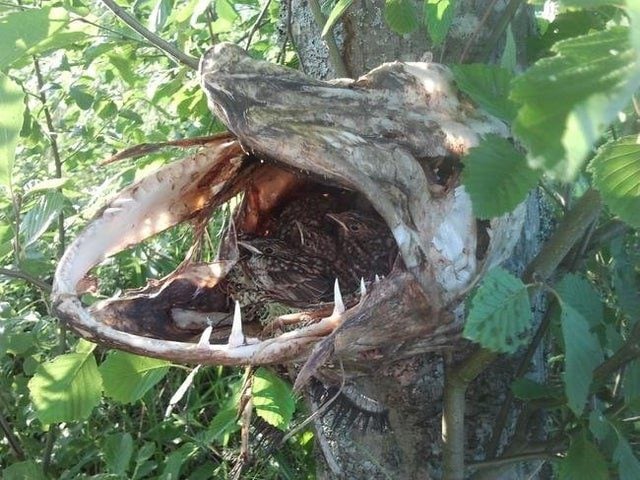
It’s a pretty good structure for a nest, with the teeth serving as an efficient form of protection against some predators. It could have been kept in the tree by locals who like to preserve fish bones. They just put them up and wait for birds to pick off the body leaving only the bone.
Coyote vs. Squirrel
Squirrels are tough to catch primarily because of their agile body structure and smaller size, making them slippery. The coyote in this image seems to have the upper hand, though. Usually, coyotes hunt in packs for bigger prey, but you find them as loners when chasing squirrels.
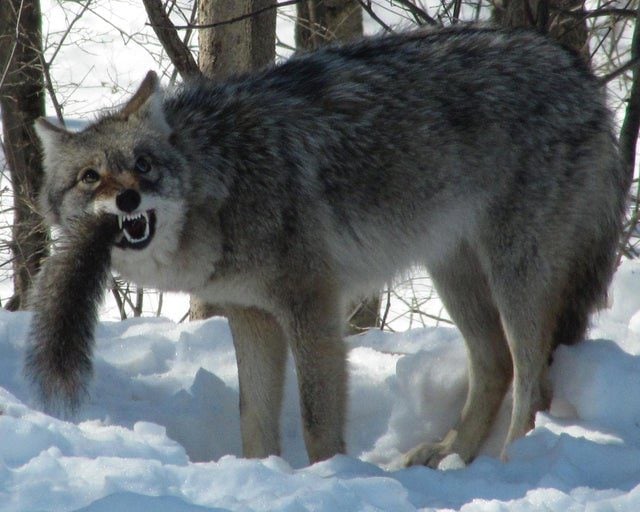
Coyotes are becoming commonplace in society, though. A study by Utah State University suggested coyote populations in 96 out of 105 American urban areas in 2016. They are guilty of coming in contact with different parasites and diseases through their diet. Their existence in urban areas has also increased the occurrence of attacks on humans.
Pufferfish Skeleton
Earlier, we discussed the pufferfish; here, we will see a clear image of the skeleton of a pufferfish. It has spines that act as modified scales, and it somehow enables the pufferfish to increase in size to more than twice their side. The fish is notorious for containing a poisonous compound known as tetrodotoxin, 1200 times more dangerous than cyanide.
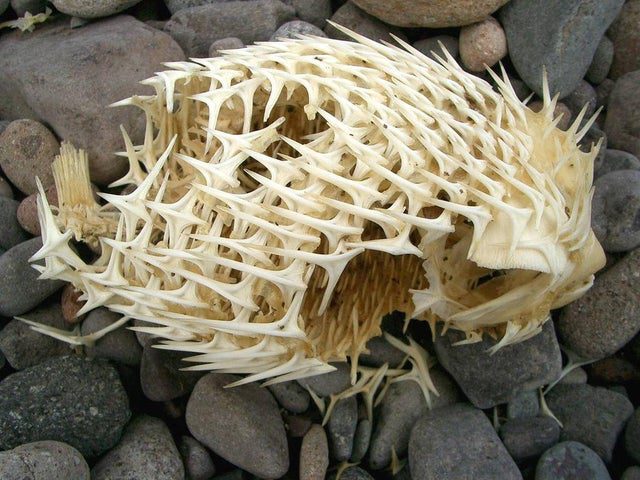
The traditional Japanese have a delicious meal made with the pufferfish called the fugu. However, preparing it is never easy, and only highly skilled chefs are allowed to prepare it. According to reports, chefs must have trained for three full years or more before they are certified even to try to cook the delicacy.
Chick With Genetic Defect
This is a rare disorder observed in chickens called Polymelia. It occurs when a chick is hatched with an additional limb or more to deviate from the natural two-legged nature identified with birds. Usually, there can be no real implication arising due to this defect. Their growth can be average like other birds.
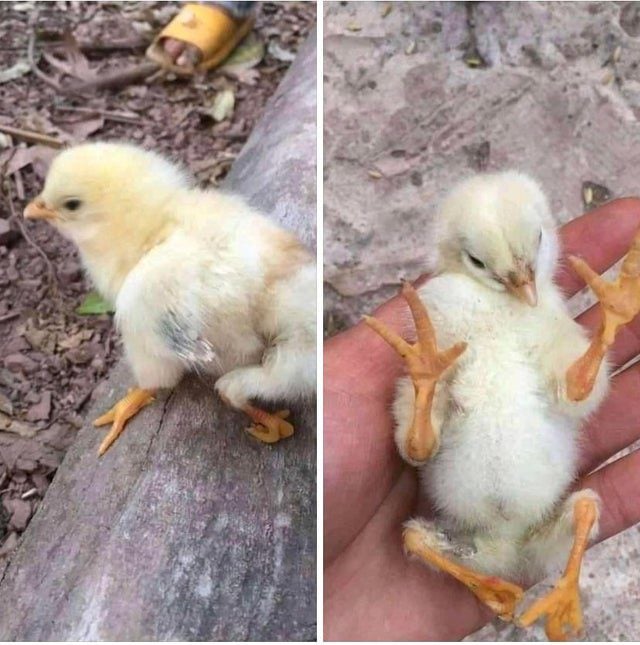
Among the probable causes of Polymelia include exposure to toxins, the environment, or genetic accidents. There was a similar occurrence in Pennsylvania back in 2005, which made the news as a chick was hatched with four legs. The chick grew to live normally, although the extra legs were non-functional even at eighteen months.
Roger the Buff Roo
Meet Roger, the muscular kangaroo dwelling in a sanctuary in Australia. He is one of the rescued wild animals kept in the sanctuary. It appeared sickly and malnourished when it got there but had grown up pretty well, obviously at about 6 foot 7 inches and weighing about 200 pounds.
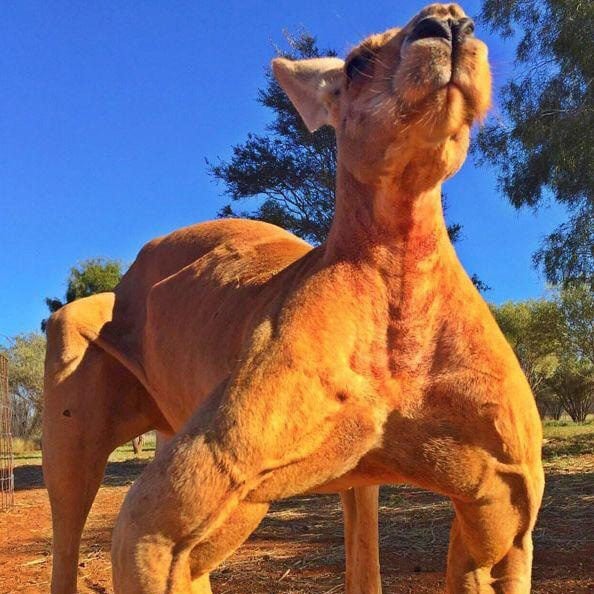
He learned to put the muscles to good use. He was renowned for participating in boxing matches with the sanctuary’s owner. Roger’s size meant that he stood tall among his peers and became his pack’s alpha male. Roger died in 2018 and will forever remain a symbol of survival and strength in the sanctuary.
Famous Jaws Poster in Real Life
JAWS is a scary movie that you don’t want to watch in the dead of night. We know it was fictional, but what if there could potentially exist a shark similar to the one depicted in the movie. Here is a terrifying image of the great white shark as seen by a British cage diver. It doesn’t look different from Steven Spielberg’s classic Jaws image.
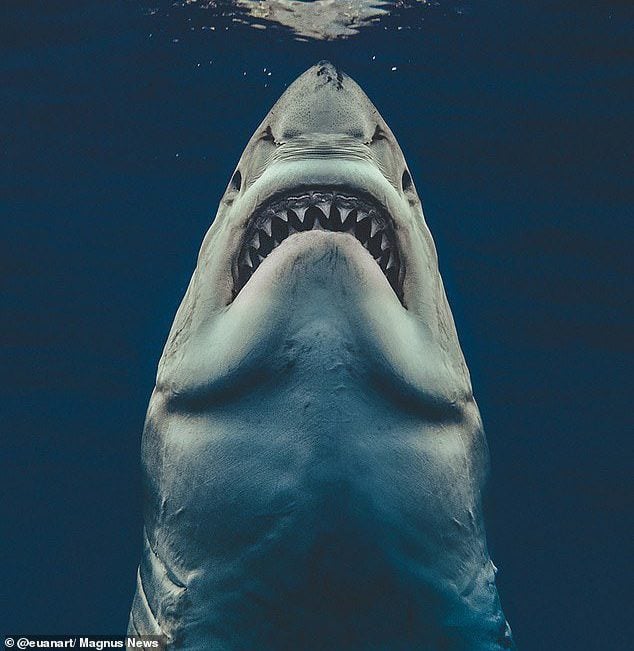
No one was harmed as there were no swimmers nearby. The movie was never designed to imitate real sharks, but finding a 17ft shark is quite scary. JAWS was much more extensive and natural from observing stuffed shark figures. The movie did come out well and is one of the best movies of the century.
Star-Nosed Mole
The star-nosed mole is a rather odd animal that many people don’t know about. They are named so because of their distinct star-shaped nose that is remarkably sensitive with over 100,000 nerve fibers. They can quickly sniff out potential edible materials and consume them quite rapidly.
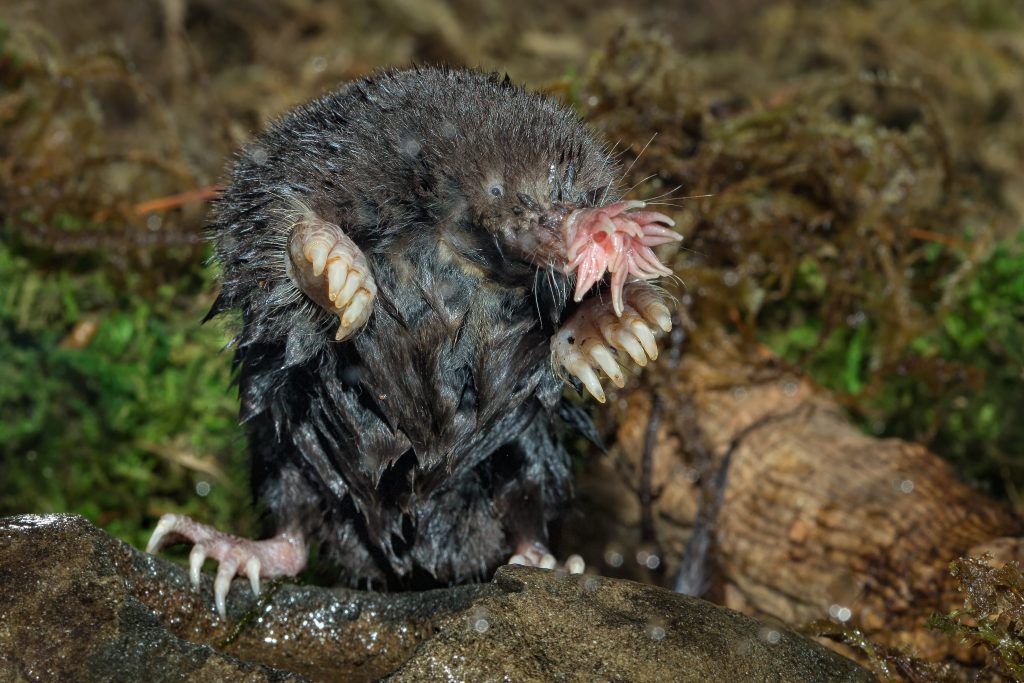
They do not grow so large, though, and can be about the size of a hamster. The moles are native to the Northern extreme of North America. Aside from their incredibly fast-eating ability, they act like amphibians because they can easily breathe underwater. They create air bubbles and attach them to objects, and inhale the air stored in these bubbles back into their lungs.
